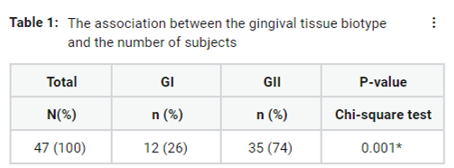Abstract
The aim of the present study was to investigate the periodontal phenotypes among young Malay males with different gingival biotypes. Forty-seven systemically and periodontally healthy young Malay males participated in this study, where 25.5% were diagnosed with thin gingival biotype and 74.5% of thick biotype. The periodontal phenotypes were measured through clinical parameters presented by the gingival thickness (GT), gingival width (GW), papilla height (PH), and crown width/crown length ratio (CW/CL). Three clusters were identified through K-means cluster ing analysis based on the parameters of the periodontal phenotypes. Cluster 1 represents narrow crown form and the average CW/CL, GW, PH and PD were 0.69, 2.92, 4.55 and 2.16 mm, respectively. Cluster 2 displayed an average of 0.76, 4.29, 4.96 and 2.14 mm for CW/CL, GW, PH and PD, respectively. Cluster 3 represents wide crown form and the average displayed for CW/CL, GW, PH and PD were 0.80, 4.85, 3.73 and 2.23 mm, respectively. There were significant differences between the three clusters (p<0.05) with respect to the GW, PH and CW/CL. This study demonstrates the difference in gingival phenotypes between young Malay males. The GW has a significant positive linear correlation (p<0.05) with CW/CL and negatively correlated with PH.
Full text article
Authors

This work is licensed under a Creative Commons Attribution-NonCommercial-NoDerivatives 4.0 International License.

